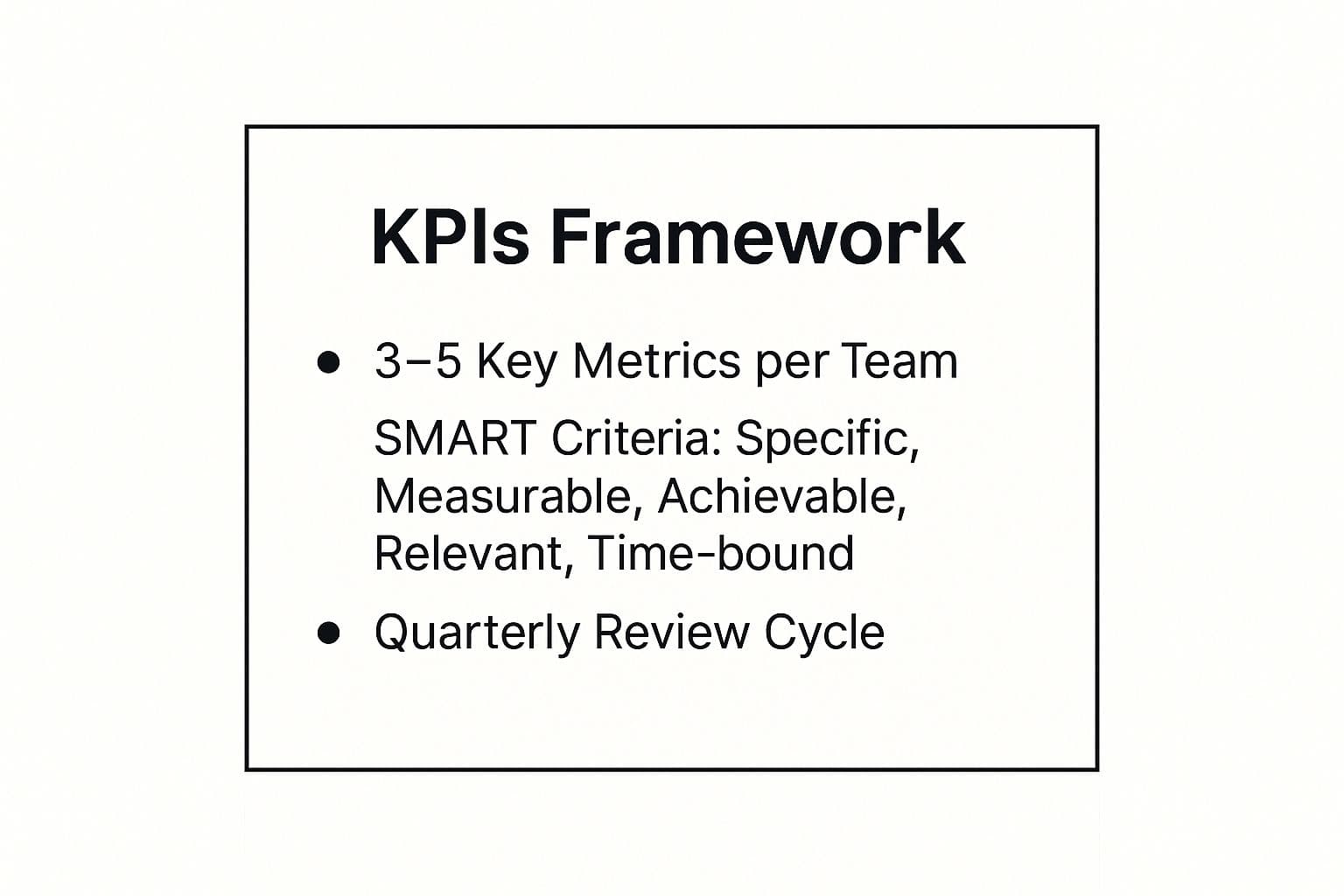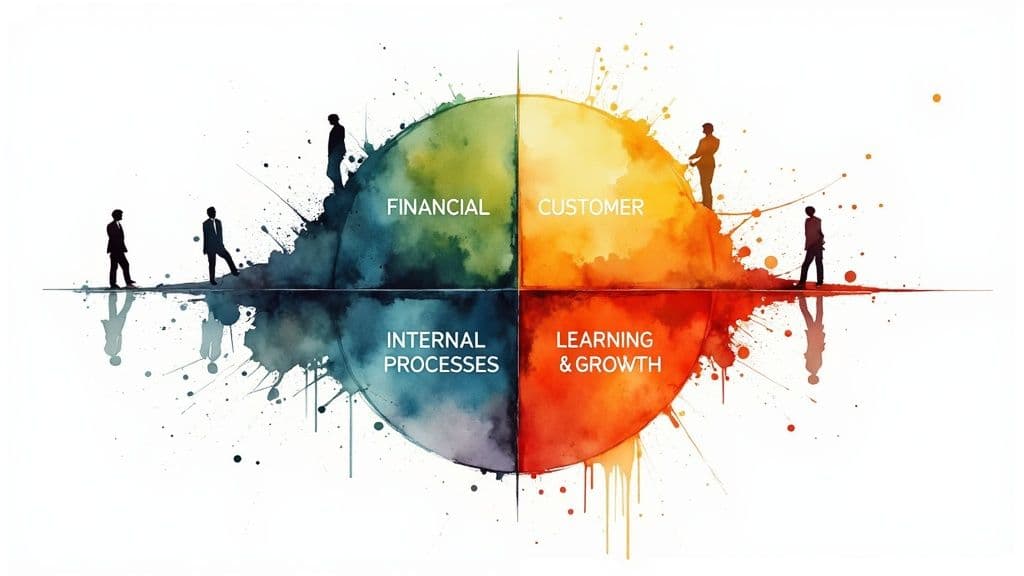In today’s fast-moving workplace, output alone rarely tells the whole story. High-engagement teams are significantly more productive, so combining quantitative metrics with human-centered feedback gives a clearer, actionable picture of team performance and where to improve.1 Effective leaders use a mix of data and development to create continuous improvement, strategic alignment, and sustained productivity.
June 27, 2025 (6mo ago) — last updated January 1, 2026 (8d ago)
Measure Team Performance: 7 Proven Methods (2025)
7 practical methods to measure team performance—KPIs, OKRs, 360° feedback, surveys, and Agile metrics—to boost productivity, alignment, and growth.
← Back to blog
7 Proven Ways to Measure Team Performance (2025)
Summary: Learn 7 practical methods to measure team performance—KPIs, OKRs, 360° feedback, surveys, Agile metrics—to boost productivity, alignment, and growth.
Introduction
In today’s fast-moving workplace, output alone rarely tells the whole story. High-engagement teams are significantly more productive, so combining quantitative metrics with human-centered feedback gives a clearer, actionable picture of team performance and where to improve.1 Effective leaders use a mix of data and development to create continuous improvement, strategic alignment, and sustained productivity.
1. Key Performance Indicators (KPIs) Framework
A Key Performance Indicators framework focuses on a curated set of measurable metrics tied to strategic goals. KPIs translate broad objectives into specific, actionable targets so team members know how daily work contributes to outcomes.
How to implement a KPI framework
- Collaborate with the team to select 4–8 KPIs the team can influence.
- Use a mix of leading indicators (predictive) and lagging indicators (output) to balance foresight with results.
- Review and revise KPIs quarterly to stay aligned with changing priorities.
Example metrics:
- Software team: sprint velocity, bug resolution time.
- Customer service: average response time, customer satisfaction (CSAT).
Key insight: Balance leading and lagging indicators to surface early risks while measuring results.

Internal link: See our guide to KPIs for teams (/guides/kpis).
2. Objectives and Key Results (OKRs)
Objectives and Key Results link ambitious objectives to measurable outcomes. An objective states what you want to achieve; key results show how you’ll measure progress. OKRs create transparency and alignment while encouraging stretch goals without tying them to compensation.2
How to implement OKRs
- Set 3–5 objectives per quarter at team level; attach 2–4 measurable key results to each.
- Hold weekly or biweekly check-ins to track progress and remove blockers.
- Keep OKRs separate from performance ratings to encourage risk-taking and learning.
Example:
- Objective: “Increase brand awareness in Q3.”
- Key Results: launch three campaigns; increase organic traffic 20%; secure five media placements.
Key insight: Use OKRs to align focus and encourage experimentation without penalizing failure.
Internal link: Learn more about OKRs and best practices (/guides/okrs).

3. 360-Degree Feedback System
A 360-degree feedback system gathers confidential input from supervisors, peers, and direct reports to produce a rounded view of an individual’s performance, leadership, and collaboration skills.3
How to implement 360-degree feedback
- Build psychological safety before launch and train raters on behavior-based feedback.
- Use anonymous, structured surveys focused on observable behaviors and impact.
- Use results for development—not direct compensation decisions—to preserve honesty.
Key insight: The value is in the development conversations that follow the feedback.
4. Balanced Scorecard Approach
The Balanced Scorecard evaluates performance across four perspectives—financial, customer, internal processes, and learning and growth—so teams align short-term activities with long-term strategy.4
How to implement a Balanced Scorecard
- Start from strategy: define cause-and-effect links across the four perspectives.
- Limit measures to a manageable set (20–25) to maintain clarity.
- Visualize the narrative with dashboards and review on a regular cycle.
Key insight: Use the scorecard to tell a strategic story through linked metrics.

5. Agile Team Velocity and Sprint Metrics
Agile velocity and sprint metrics track how much work a team completes each sprint, helping forecast capacity and improve planning. This approach emphasizes team-level delivery trends rather than individual output.5
How to implement Agile and sprint metrics
- Adopt a consistent sprint length and estimate work using story points.
- Calculate average velocity after several sprints and use it for realistic sprint planning.
- Use burn-down and cycle-time charts to identify bottlenecks and quality trends.
Key insight: Track velocity for a single team over time; don’t compare velocities across teams.
6. Team Effectiveness Surveys and Assessments
Surveys and structured assessments measure team health, communication, psychological safety, and alignment—factors that often explain the why behind performance numbers. Google’s Project Aristotle highlighted psychological safety as a top predictor of team effectiveness.2
How to implement team effectiveness surveys
- Choose a validated instrument or design a focused pulse survey.
- Administer anonymously and dedicate time to discuss aggregated results.
- Turn insights into a concrete action plan co-created with the team.
Key insight: The data matters only if it fuels facilitated conversations and clear next steps.
7. Peer Review and Ranking Systems
Peer review lets colleagues evaluate one another on collaboration, skill, and day-to-day impact. When used responsibly, it uncovers hidden contributors and supports reciprocal accountability.6
How to implement peer review and ranking systems
- Provide training on objective, behavior-based feedback and calibration processes.
- Use peer input as one of multiple data points in assessment—not the sole determinant.
- Ensure transparency about criteria and how feedback will be used.
Key insight: Peer systems work best in mature teams where trust and fairness are established.
Framework Comparison
| Framework | Complexity | Resources | Outcomes | Ideal Use Cases | Advantage |
|---|---|---|---|---|---|
| KPIs | Moderate | Moderate | Clear, measurable progress | Teams needing objective benchmarks | Data-driven focus |
| OKRs | High | Moderate–High | Ambitious alignment | Organizations seeking stretch goals | Drives alignment and innovation |
| 360 Feedback | High | High | Holistic development view | Leadership development | Comprehensive perspectives |
| Balanced Scorecard | High | High | Strategic alignment | Cross-functional strategy | Links strategy to metrics |
| Agile Velocity | Moderate | Moderate | Predictable delivery | Agile development teams | Real-time planning |
| Team Surveys | Moderate | Moderate | Insight into team health | Teams focusing on collaboration | Captures intangible factors |
| Peer Review | High | Moderate–High | Peer accountability | Mature collaborative teams | Reveals hidden strengths |
Choosing Your Framework: Action Steps
- Identify your primary goal—predictability, innovation, development, or alignment.
- Choose one core framework and one complementary human-centered approach (for example, KPIs + surveys, or OKRs + 360 feedback).
- Pilot the approach with one team, collect feedback, and iterate.
- Communicate purpose, metrics, and how results will be used to build trust.
A measurement strategy should be transparent, fair, actionable, and balanced between quantitative and qualitative signals. Start with a simple, repeatable process and scale as you learn.
Frequently Asked Questions
Q: Which method should I start with for a small team?
A: Start with a small set of KPIs and a short team effectiveness pulse survey. KPIs give clarity; the survey uncovers process or collaboration gaps.
Q: How do I avoid measurement harming trust?
A: Separate development tools (like OKRs and 360 feedback) from compensation. Emphasize psychological safety and use metrics to coach, not punish.
Q: Can I combine frameworks?
A: Yes. Pair a strategic framework (Balanced Scorecard or OKRs) with people-focused methods (360 feedback or team surveys) for a balanced view.
Quick Q&A — Practical Decisions
Q: What’s the fastest way to start measuring performance? A: Pick 3–5 KPIs tied to your current goals and run a two-week pulse survey to spot immediate issues.
Q: How often should we review metrics? A: Monthly for operational KPIs, quarterly for strategic OKRs and the Balanced Scorecard, and after each pilot for qualitative feedback.
Q: What’s one mistake to avoid? A: Making metrics punitive. Use them to inform coaching and improvement, not punishment.
Ready to centralize your team’s goals and performance data? See how Fluidwave can help implement KPIs and OKRs while keeping feedback and projects aligned: https://fluidwave.com.
Focus on What Matters.
Experience lightning-fast task management with AI-powered workflows. Our automation helps busy professionals save 4+ hours weekly.